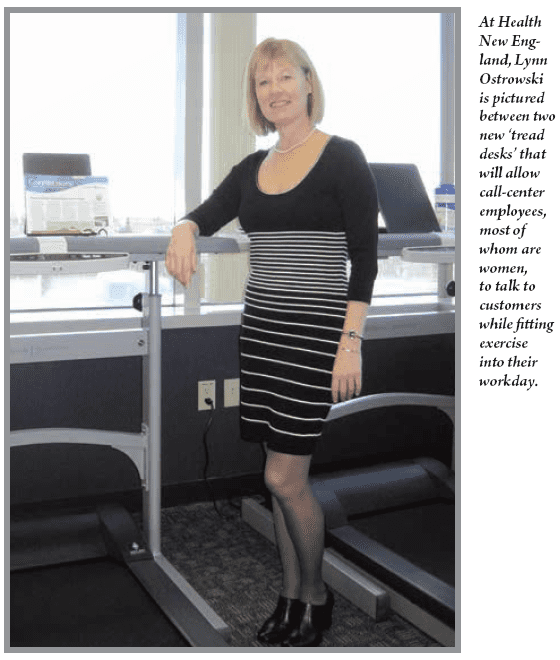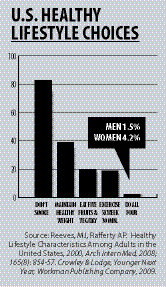Creating a Healthy Lifestyle Comes Down to Making Behaviors Automatic
It’s not easy to get in shape and stay fit, especially for professional women who have to juggle the responsibilities of job and family while still finding time for a daily workout. But many women have managed to do just that. It begins with simple decision making, one choice at a time, until a fitness routine becomes an automatic behavior. That may sound simple, but getting to that point can be a real challenge.
Grace Barone, a local realtor and optical stylist, said she dearly loves her 26-year old daughter, Marisa — most of the time, anyway.
She makes a clear exception, sort of, when Marisa takes the role of being Barone’s personal trainer, which is quite often.
“Whenever we’re running and I can’t do any more, she’s there to tell me to stop whining,” said Barone, adding that her daughter has helped inspire her to take fitness and proper nutrition to higher levels than at any time in her life. Indeed, in addition to running three days a week, she’s at the Scantic Valley YMCA at 5:30 a.m. for spinning classes and a combination of the elliptical trainer and free weights.
Meanwhile, Tracey Parent, an executive assistant to the vice president of Supply Chain for LEGO Systems Inc., who also sells Lia Sophia Jewelry, works out with a trainer at Club Fitness on Mondays and Fridays; runs on Tuesdays, Thursdays, and Saturdays with a running club; and is at the gym daily at 6 a.m.
Kelsey Rhodes, an event consultant at the Log Cabin & Delaney House, finds it quite difficult to partake in morning workouts — but she puts governors in place to make sure she gets in her exercise at the other end of the day. She sets a schedule at the beginning of the week to pack gym clothes before work, which makes it much harder to make an excuse when the bag is staring her in the face at the workday’s end.
These stories all vary in some respects, but there is one powerful common denominator — the individual’s ability to create a healthy, or more healthy, lifestyle through smart decision making — and making behavioral patterns automatic and habitual.
Jasmin Hutchinson, assistant professor of the Exercise Science and Sport Studies Department at Springfield College, said it’s much like brushing one’s teeth or learning to drive.
“Think about when you first learned to drive; it probably took a lot of conscious processing on your part, and you didn’t talk or listen to the radio because it was too distracting,” she explained. “Now, after years of practice, driving is a habitual behavior; you do it pretty much unconsciously.”
The same can be accomplished when it comes to fitness and proper choices with regard to nutrition and overall wellness, she went on, adding that forming habitual behaviors and making decisions incorporate two different parts of the brain (more on that later), and that changing behavior is more doable than most would believe.
Judy Van Raalte, a professor of Psychology at Springfield College, agreed. She said there are proven steps for behavioral and habitual change, but the process starts with taking responsibility for one’s health.
And the need for better decision making and better automatic behaviors when it comes to healthy living is made clear by the ‘healthy-lifestyle chart’ published by Health New England (below). It speaks volumes about an alarming percentage of men and women who are not making healthy decisions, when many have the means to make them.
For this issue and its focus on women’s health, HCN takes an in-depth look at how many women are able to take excuses out of the equation and make smart decisions, and how others can do the same.
Study in Self-improvement
“I used to come up with every excuse in the book, but now I make fitness a part of every day,” said Lisa Cohen, an account service representative at Alden Credit Union, adding that, five years ago, she made the decision to change.
“I invested in me and put a gym in my basement, so if I can’t do a 10-minute walk on my break and at lunch due to rain, I now have no excuse.”
Linda Edwards, a self-proclaimed “reformed couch potato” and director of marketing at Glenmeadow retirement community, runs with several women who belong to the Pioneer Valley Women’s Running Club (PVWRC) and is up and out the door by 5:15 a.m., regardless of the season. The club includes women of all ages from different backgrounds and professions, but they have one thing in common — they support each other to stay fit and healthy.
“When I turned 50 last summer, one of my running buddies said, ‘when I turned 50 I did my first triathlon — you should try one.’ So she trained with me, and I did my first triathlon last September,” Edwards told HCN. “I probably never would have done it on my own.”
Christine Garstka, a realtor for Coldwell Banker in Longmeadow and mother of two small children, attends a trainer-run ‘boot camp’ every Monday, Wednesday, and Friday evening, using the TRX Suspension Training system of canvas strips, ropes, and isometrics.
“Those are my nights, and I book it into my schedule like a listing appointment; it’s what I do.”
When Donna Shea, director of the Technology Transfer Center at the University of Connecticut, finished graduate school a few years ago, she joined the PVWRC with the primary goal of losing weight, “but it is no longer about weight,” she explained. “This is the most successful I have ever been in my life at being diligent about my fitness schedule, and I owe that to the members of the PVWRC.”
Jessica Lemieux, director of strategic alliances for Alden Credit Union and a former New England Patriots cheerleader, tells a similar story. “Working out is my second job; it’s ingrained in my brain.”
With a long history of dance and cheering for the UMass Minutemen, she’s up at 5:30 a.m. six days a week, and her regimen includes a combination of early-morning cardio workouts, Tony Horton’s P90X, treadmill, and outdoor running.
What would make her miss a work out? “Not much,” she stated emphatically. “If I have something to do in the week, I tend to work around it.”
While these stories are impressive and inspiring, the women authoring them are, sadly, still very much in the minority, said Lynn Ostrowski, director of Corporate Relations and Brand at Health New England, who also oversees population health management for the company’s 130,000 members. To paint a picture of the region’s serious healthcare crisis, she explained HNE ‘buckets,’ which identify people in four categories of health.
The first bucket is a ‘healthy’ state with an appropriate body-mass index (BMI), no diagnosis of a diseased state, a healthy diet, exercise, and no smoking. Only 10{06cf2b9696b159f874511d23dbc893eb1ac83014175ed30550cfff22781411e5} to 15{06cf2b9696b159f874511d23dbc893eb1ac83014175ed30550cfff22781411e5} of HNE’s customers are in this bucket.
The second category involves risk factors for conditions like elevated cholesterol, blood pressure, higher BMI, etc. This represents 20{06cf2b9696b159f874511d23dbc893eb1ac83014175ed30550cfff22781411e5} to 25{06cf2b9696b159f874511d23dbc893eb1ac83014175ed30550cfff22781411e5} of HNE customers.
The third bucket represents a whopping 30{06cf2b9696b159f874511d23dbc893eb1ac83014175ed30550cfff22781411e5} to 40{06cf2b9696b159f874511d23dbc893eb1ac83014175ed30550cfff22781411e5} of HNE customers and shows confirmed diagnoses of one or more diseases, like diabetes, coronary artery issues, chronic conditions, etc.
The final group is one of severe health conditions, such as cancer or multiple anomalies that require case management to navigate the system. Fewer than 1{06cf2b9696b159f874511d23dbc893eb1ac83014175ed30550cfff22781411e5} are in this group, and both this group and the third group cost the most to the healthcare system.
In an effort to change the numbers within these buckets, Ostrowski continuously educates the public, and at the Western Mass Business Expo last fall, she presented the healthy-lifestyle chart, which shows that more than 80{06cf2b9696b159f874511d23dbc893eb1ac83014175ed30550cfff22781411e5} of the population doesn’t smoke, which is a positive health statistic, but it’s mostly downhill from there.
The fifth block on the chart shows that only 1.5{06cf2b9696b159f874511d23dbc893eb1ac83014175ed30550cfff22781411e5} of men and 4.2{06cf2b9696b159f874511d23dbc893eb1ac83014175ed30550cfff22781411e5} of women in the U.S. are non-smokers, maintain a healthy weight, eat five fruits or vegetables per day, and get at least 30 minutes of some form of exercise five times a week.
Changing those numbers comes down to education, said Ostrowski, but also a willingness on the part of individuals to take charge of their own health and make healthy decisions and behaviors automatic.
“We rely so heavily on the medical community when we need to learn how to take responsibility for our own health,” she told HCN. “If we could get people to engage in managing their own health by their behaviors each day, we could have a significant impact on the overall cost of healthcare.”
Motivational Factors
Changing behaviors is not often easy, said Hutchinson, but it can be accomplished, again, by work to make the desired behavior automatic.
“Habitual behaviors require little cognitive processing,” she said. “Goaldirected decision making is carried out by our pre-frontal cortex, based on a consideration of possible outcomes and future lines of action.”
This requires willpower, which can be mentally taxing, she continued, and research shows that, the more one taps into this throughout the day, the less reliable it becomes. “So by the end of the day, when you are worn out, you are far less likely to hit the gym if it’s not a habit.”
On the flip side, habitual behavior is governed by a much more primitive part of the brain that acts as one’s own personal autopilot, she went on. “Once this habit center is programmed, it requires no effort on your part — so habit-based decision making is more of a reflex-like response that doesn’t get disrupted as easily.”
Hutchinson recommends that a woman start with one deliberate and non-negotiable thought, such as, “it’s Wednesday; I go to the gym — end of story,” which she said psychologists call ‘good constraint.’ Another examples might be ‘no, thank you, I don’t eat bread at restaurants.’ By taking away the decision piece, an individual can take away the stress of purposeful decision making, she noted.
But getting to the good constraint point may require a series of selfawareness steps, according to Van Raalte.
“Any behavior, like quitting smoking or losing weight, may take a few tries to get there,” she said. “Asking a question like, ‘if you lacked the motivation to work out by yourself, did you think of trying a group class this time?’ could help.”
She explained to HCN the Transtheoretical Model (TTM) identified in 1977 by James Prochaska, a renowned psychologist at the University of Rhode Island, who made it his life’s mission to help people break their bad habits — and create good behaviors — after he lost his father to alcoholism.
After years of studying people who had successfully changed their habits, Prochaska detected a pattern and created the ‘stages of change’ model. He has often said, “the only mistake you can make is to give up on yourself.”
Van Raalt said that any woman knowing the TTM model can identify her current stage and continue from there to create a new healthy habit. The simplified stages are as follows:
• Precontemplation (not ready);
• Contemplation (getting ready);
• Preparation (ready);
• Action (acquiring new behavior);
• Maintenance (sustaining new habit); and
• Termination (zero temptation).
For starting healthier habits, HNE believes that the workplace is a good place to start. Not only is it a nonsmoking company, meaning employees cannot be smokers, but two ‘tread desks’ — treadmills with attached desks — have been installed in the member-services center, staffed by 36 employees, 90{06cf2b9696b159f874511d23dbc893eb1ac83014175ed30550cfff22781411e5} of whom are women.
“We put in tread desks because everybody else can go take a walk, but for the call center, there’s no give for them,” said Ostrowski. Within the next few weeks, both desks will have connected computers so employees can actually walk and talk to customers at the same time.”
Ostrowski noted that most experts believe it takes 12 to 16 weeks to form a habit. For Tracey Parent, her fitness habit was formed quicker than most after her son decided to join the Marines.
“It was on my bucket list to run a half-marathon, and I thought about the boot-camp training and all the pain he was going to endure,” she said. “I figured, if he could do it, I could do a half, and when he went to Afghanistan, the running helped with my worrying and stress.”
Dr. Melissa Johnson, a local plastic surgeon and owner of Pioneer Valley Plastic Surgery, is a mother with two small children who, with the help of her husband, has no excuses to miss her
morning run.
Like all the women HCN spoke with, Parent and Johnson are definitely in the ‘termination stage’ because they have a confirmed habit.
“I found something I look forward to,” added Johnson. “It’s not perceived as a chore or one more thing on my list
to do today.”
Minority Report
All these women have something to look forward to — even Barone, who is pushed harder than she likes sometimes by her daughter.
Specifically, they have been able to retire all or most of the excuses that used to keep them from the gym or the running track, and they have made their healthier habits automatic.
There are lessons here for all those who find themselves on the wrong end of that healthy-lifestyle chart, said Ostrowski, adding that improvement in one’s health and well-being start with assuming responsibility for what happens with their body.
And also with the ability to ‘just do it’ and allow the mind to triumph over matter.







Comments are closed.